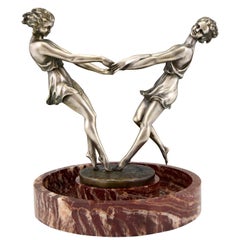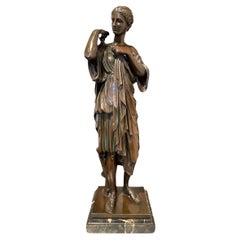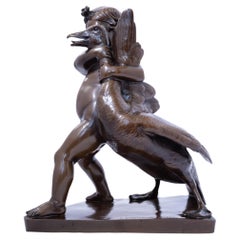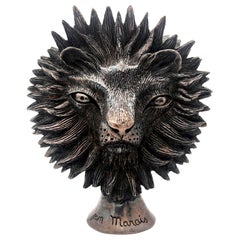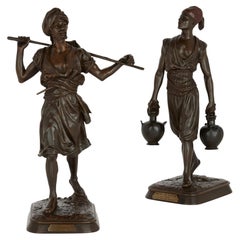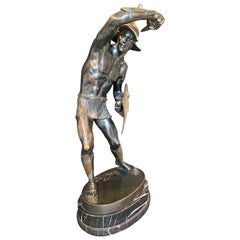Bronze Figurative Sculptures
to
758
4,212
171
126
88
1,715
2,409
297
915
556
470
128
57
216
119
60
80
73
86
105
79
584
259
243
194
178
91
70
50
31
27
17
17
12
7
6
5
1
1
7,258
4,509
3,895
3,536
2,870
2,127
1,972
3,196
1,803
486
410
350
Height
to
Width
to
4,509
4,385
4,425
48
28
27
26
24
Material: Bronze
Art Deco Centerpiece with Bronze Sculpture of Dancing Girls Andre Gilbert, 1925
By Andre Gilbert
Located in Antwerp, BE
Whirling, spectacular circular marble centerpiece with a bronze sculpture of two dancing girls holding hands by the French artist Andre Gilbert, circa 19...
Category
1920s French Art Deco Vintage Bronze Figurative Sculptures
Materials
Marble, Bronze
Diana of Gabii in bronze
Located in 'S-HERTOGENBOSCH, NL
Diana of Gabii in bronze on a basic in marble.
Beautiful patina, Cast by Fumiére & Cie, Paris
Category
1880s French Grand Tour Antique Bronze Figurative Sculptures
Materials
Bronze
$1,612
A Patinated Bronze Sculpture of a Boy with a Goose
Located in 263-0031, JP
After the Hellenistic original, apparently by the sculptor Boethus, a marble variant of which can be found in the Louvre. This sculpture, along with the Dying Gaul and the Scythian K...
Category
Late 19th Century French Hellenistic Antique Bronze Figurative Sculptures
Materials
Bronze
$1,184 Sale Price
20% Off
Jean Marais (1913-1998)The beast and the beauty (1947) bronze sculpture signed.
By Jean Marais
Located in palm beach, FL
This creation called Zoomorphe is a sculpture inspired by Beauty & The Beast by Jean Cocteau. This work created by JEAN MARAIS and manufactured in the artist's workshops in Vallauris...
Category
1980s French Vintage Bronze Figurative Sculptures
Materials
Bronze
Pair of Large Orientalist Bronze Figures by Emile Pinedo and Marcel Debut
By Émile Pinedo
Located in London, GB
A pair of large Orientalist bronze figures by Emile Pinedo and Marcel Debut
French, Late 19th Century
Arabe en Marche: height 65cm, width 42cm, depth 28...
Category
Late 19th Century French Moorish Antique Bronze Figurative Sculptures
Materials
Bronze
$26,460 Sale Price / set
20% Off
"Gladiator with Shield and Helmet, " Rare, Large Bronze Sculpture with Nude Male
By Bruno Zach
Located in Philadelphia, PA
The first example of this sculpture we have seen, this striking depiction of a male gladiator -- clothed in nothing but a short mail skirt - is shown in the midst of battle, one arm ...
Category
1910s German Beaux Arts Vintage Bronze Figurative Sculptures
Materials
Bronze
Bronze & Lucite Abstract Sculpture Man & Woman By Arthur Schneider
Located in Toledo, OH
Arthur Schneider (1929-1996) was a Michigan artist who was known for sculpture. This bronze is an abstract of a man and woman embracing. This piece sits upon a signed Lucite base. Th...
Category
20th Century North American Modern Bronze Figurative Sculptures
Materials
Bronze
Bronze sculpture of a Cupid, after Lemire
Located in Paris, FR
Green patina bronze proof of a cupid stringing his bow, after a marble original presented at the 1814 Salon by Charles Gabriel Sauvage dit Lemire (1741-1827). Love is shown seated an...
Category
1880s French Antique Bronze Figurative Sculptures
Materials
Bronze
Child sculpture in Bronze and marble
Located in Ciudad Autónoma Buenos Aires, C
Child sculpture in bronze and marble
Category
1920s French Art Deco Vintage Bronze Figurative Sculptures
Materials
Marble, Bronze
Bronze Sculpture, African Head, On Base, 20th Century
Located in MARSEILLE, FR
African head in bronze with black patina, on black and white marble base
Very good quality of carving and patina
Base with some wear and small chips of use
In the style of Riccard...
Category
20th Century French Art Deco Bronze Figurative Sculptures
Materials
Marble, Bronze
Large Antique Austrian Cold-Painted Bronze Figurative Sculpture by Bergman
Located in London, GB
Large antique Austrian cold-painted bronze figurative sculpture by Bergman
Austrian, c. 1910
Height 33cm, width 19cm, depth 14cm
...
Category
Early 20th Century Austrian Islamic Bronze Figurative Sculptures
Materials
Bronze
$8,268 Sale Price
20% Off
19th Century French Bronze Sculpture "The Lady with the Ducks" Signed Moreau
Located in Dallas, TX
This antique sculpture composition is a beautiful example of the works of one France favorite sculptors, Hippolyte Moreau. Crafted in France, circa 1880, the sculpture features a you...
Category
Late 19th Century French Belle Époque Antique Bronze Figurative Sculptures
Materials
Bronze
Limited Edition Bronze Sculpture entitled "Coquette" by Erte
By Erté
Located in London, GB
A fabulous limited edition cold painted bronze figure of an elegant beauty dressed in a full length gown looking into her pocket mirror with excellent colour and very fine hand finished detail. Signed Erté, numbered 179/375, dated 1986 and with foundry mark.
ADDITIONAL INFORMATION
Height: 46 cm
Circa: 1985
Foundry: Fine Art Acquisitions
Materials: Bronze
Book Ref: Erté The Last Works by Eric Estorick
Page no. 104
SKU: 9104
ABOUT
Erté La Coquette
Erté Sculpture
Erté La Coquette – Sculpture as such has been a rather late arrival in Erté’s life, but his three-dimensional creativity began long before he started to work with Paul Poiret in Paris in 1913. It began at his house in St. Petersburg in 1897, when he was five years of age and created a little theatre using his mothers empty perfume bottles...
Category
20th Century French Art Deco Bronze Figurative Sculptures
Materials
Bronze
A Patinated Bronze Statue of a Seated Classical Scholar Signed Doriot
By Theodore Doriot
Located in Vancouver, British Columbia
A finely cast bronze sculpture of an expressive classically draped Greek scholar seated on a curule chair holding a lyre in one hand and an an open scroll in the other, both symb...
Category
Late 19th Century French Neoclassical Revival Antique Bronze Figurative Sculptures
Materials
Bronze
Cast Bronze and Marble Shepherdess with Sheep Sculpture Signed D. Alonzo
Located in Buenos Aires, Buenos Aires
Cast bronze and marble shepherdess with sheep sculpture signed D. Alonzo. France, early 20th century.
Category
Early 20th Century French Art Nouveau Bronze Figurative Sculptures
Materials
Marble, Bronze
Large Vintage Nepalese Gilt Bronze Vajrasattva Buddha, Mid 20th Century
Located in Austin, TX
A large and impressive vintage gilt bronze figure of the tantric Buddha Vajrasattva, the Diamond Thunderbolt, mid 20th century, Nepal.
Crafted of cast and richly gilt bronze, Vajrasattva sits in vajrasana, or full lotus position, his torso slightly bent at the waist. He holds an upright vajra scepter in one hand, raised at heart level. His other hand, resting on his hip, would originally have held a a ghanta, or bell, which is now missing.
He is festooned in jewelry, including a five pointed crown, earrings, necklaces and armlets, all studded with coral and turquoise beads. His long hair falling in elegant tresses around his shoulders, the rest tied up in a high chignon topped by a vajra.
Vajrasattva wears a dhoti covering his lower half. The dhoti intricately cast and carved with a scrolling vegetal design, and featuring images from the Ashtamangala, or Eight Auspicious Emblems, including the conch, endless knot, and double fish. Scarves billow out around his arms.
The tantric Buddha sits upon a tall double lotus throne, the back with more intricately cast decorations of dragons and lotus blossoms against dense vegetal scrolls. The base sealed with a dented copper plate inscribed with a visvajra, or double vajra...
Category
Mid-20th Century Nepalese Tibetan Bronze Figurative Sculptures
Materials
Coral, Bronze
Bronze Statue of Arlequin by Charles-René de Paul de Saint-Marceaux
Located in Los Angeles, CA
A Bronze Statuette of Arlequin by Charles-René de Paul de Saint-Marceaux.
Cast by Barbedienne.
The mischievous Harlequin, arms crossed in contemplation, wearing a grin and a mask, treading the boards of the stage, as befits his leading place in the Commedia dell'arte. Signed by the fondeur, Ferdinand Barbedienne, having the foundry cachet, and dated 1879, and the sculptor's name, St. Marceaux.
French, Circa 1880.
Paul de Saint-Marceaux (1845-1915) Son of a Reims wine merchant, entered the Ecole des Beaux-Arts de Paris under the tutelage of Jouffroy, exhibiting at the Salon of 1868, studying later in Italy. Considerable success followed, and he was awarded gold medals at the Paris Exposition Universelle of 1889, having been elected as a Chevalier to the Legion d'Honneur in 1880, and later becoming an officer. His public Parisian works may be seen in the Champs-Elysees (Alphonse Daudet the noted novelist) and Alexander Dumas...
Category
1870s French Antique Bronze Figurative Sculptures
Materials
Bronze
Object 01 Set by Herma de Wit
Located in Geneve, CH
Object 01 set by Herma de Wit, 2020
Edition: 30 + 3AP
Dimensions: Small: 9 x 17 x 15cm
Medium: 11 x 18 x 14cm
Large: 12 x 23 x 16cm
Materials: bronze marbled.
Nature, a boundless so...
Category
2010s Dutch Bronze Figurative Sculptures
Materials
Marble, Bronze
$4,537 / set
German Black Bronze white marble Art Nouveau sculpture, woman blowing bubles
By Thomas Germany
Located in Valladolid, ES
Very beautiful and refined antique dark patinated solid bronze sculpture depicting a naked woman blowing bubbles
It is of German origin and dates from around 1920. Unsigned.
This b...
Category
1920s German Art Nouveau Vintage Bronze Figurative Sculptures
Materials
Marble, Bronze
$964 Sale Price
41% Off
French Mid-19th Century Louis XVI Style Patinated Bronze Statue
Located in West Palm Beach, FL
A sensational and large scale French mid 19th century Louis XVI st. patinated bronze statue of Diana the Huntress, signed by Barbedienne. Diana dressed in classical attire and is rea...
Category
19th Century French Louis XVI Antique Bronze Figurative Sculptures
Materials
Bronze
'Girl seated' One of a kind bronze sculpture
By RinDesign
Located in London, GB
Girl seated' One of a kind abstract figure sculpture hand crafted and cast in bronze in the lost wax process.
Size 28cmH x 7cmW x8cmD
One of a kind and signed.
Category
21st Century and Contemporary British Modern Bronze Figurative Sculptures
Materials
Bronze
$937 Sale Price
20% Off
Pair of Neoclassical Patinated Bronze Nymphs Sculptures Torchere Lamps/Pedestal
Located in Guaynabo, PR
This is a pair of large heavy patinated bronze Greek/Roman nymphs sculptures torchere lamps. They depict a pair of semi nude females dressing classica...
Category
20th Century Unknown Neoclassical Revival Bronze Figurative Sculptures
Materials
Bronze
$12,000 Sale Price / set
20% Off
19th Century Bronze from Moulin
Located in Madrid, ES
19th century bronze from Moulin
Elegant 19th century bronze signed by the author. In Patinated bronze and simulation of porphyry. Measures: 50 x 35 x 16 cm
Good condition.
Category
19th Century French Baroque Antique Bronze Figurative Sculptures
Materials
Bronze
$1,671 Sale Price / item
20% Off
20th Century Austrian Cold-Painted Bronze Entitled "Fleur" by Lorenzl
Located in London, GB
A fabulous early 20th Century Art Deco cold painted bronze figure of a naked dancer in an elegant flowing pose, exhibiting excellent colour and fine hand finished detail, raised on a green onyx base and signed Lorenzl
Additional Information
Measures: Height: 25 cm
Width: 11 cm
Depth: 7 cm
Condition: Excellent Original Condition
Circa: 1925
Materials: Cold painted Bronze & Green Onyx
Book Ref Art Deco and Other Figures by Bryan Catley
Page No: 225
ABOUT
Lorenzl Fleur
Josef Lorenzl, Austrian 1892 ~ 1950
Lorenzl Fleur – When looking to the designs of the Art Deco period one talented sculptor and ceramist that cannot be ignored is Josef Lorenzl. A master designer, his bronze statuettes and ceramic figural work epitomise the era perfectly. As with Preiss, Chiparus and Colinet the other great sculptors from this period, Lorenzl was inspired by the female form and the new found freedom that women enjoyed, which he executed beautifully both in his bronze and ceramic designs.
Pictured right: A Josef Lorenzl Cold-Painted Art Deco Bronze and Ivory...
Category
1930s Austrian Art Deco Vintage Bronze Figurative Sculptures
Materials
Bronze
Amazing Mercury Sculpture in Bronze 20th Century
Located in Madrid, ES
Amazing Mercury sculpture in bronze H: 190cm 20th century
Lost wax and patinated bronze reproduction of the Mercury sculpture by Giambologna.
The ...
Category
20th Century Italian Modern Bronze Figurative Sculptures
Materials
Bronze
$12,896 Sale Price
20% Off
A Bronze Figure of Napoleon, 19th Century
Located in ARMADALE, VIC
A Bronze Figure of Napoleon, 19th Century
Provenance:
Private Melbourne Collection.
Description:
In full military dress, his sword sheathed and arms folded over his chest, his ri...
Category
19th Century French Empire Antique Bronze Figurative Sculptures
Materials
Bronze
Bonsai Cast Bronze Sculpture in Verdigris Finish on Marble Base by Elan Atelier
By Elan Atelier
Located in New York, NY
Bonsai Cast Bronze Sculpture in Verdigris Finish on Marble Base by Elan Atelier
Intricate lost wax cast bronze sculpture of a Bonsai Tree in Verdigris bronze on marble base by Elan ...
Category
2010s European Modern Bronze Figurative Sculptures
Materials
Marble, Bronze
Bronze Sculpture "Insect TOTEM"
Located in Saint-Ouen, FR
The sculpture is signed at the back but unidentified yet.
Measures: Bronze sculpture
Height 43 cm, length 13 cm, depth 13 cm
Stone base
Height 15 cm, length 15 cm, depth 15 cm.
Category
20th Century Bronze Figurative Sculptures
Materials
Stone, Bronze
Raoul Larche: bronze sculpture of Jeanne d'Arc
Located in Zemst, BE
Impressive bronze sculpture by french artist François-Raoul Larche (1860-1912).
Representing Jeanne d'Arc
Dated: +/- 1900
High quality bronze finished a in double colour patina.
...
Category
Early 20th Century French Neoclassical Bronze Figurative Sculptures
Materials
Bronze
« La Baigneuse » ou « La Nymphe prenant son bain » (1757)
Located in Ixelles, BE
Étienne-Maurice Falconet (1716-1791), "The Bather" or "The Nymph Bathing" (1757)
Artistic Explanation:
The Nymph Bathing is a masterpiece of 18th-century French sculpture, created...
Category
1750s French Baroque Antique Bronze Figurative Sculptures
Materials
Bronze
19th Century Silvered Bronze Athénienne Jardinière by Ferdinand Barbedienne
Located in Oxfordshire, United Kingdom
A French silvered-bronze athénienne by Ferdinand Barbedienne, Paris, last quarter 19th century with a revolving liner, the frieze applied with bucrania suspending ribbon-tied berried laurel swags above a border of bellflowers on a stippled ground above three seated female sphinxes issuing stylised foliage and scrolls on lion monopodia cast with the mask of Hercules, scrolling foliage and anthemions joined by stretchers, raised on a concave-sided triform marble base on a further thin silvered-bronze base, inscribed to the tripod base 'F. BARBEDIENNE'
Measures: 103.3cm. high, 41.5cm. diameter; 3ft. 4 3/8 in, 1ft. 4 1/4.
This impressive athénienne is a key reminder of the longevity of a particular model and design’s success from Antiquity through to the 19th century and up until this day. Typically known as the ‘Trépied du Temple d’Isis’, this athénienne is designed after the Roman antique originally found at Pompeii and now at the Museo Archeologico Nazionale, Naples (fig.1). From being for example an inspiration for the baptismal font of Napoléon’s son in 1811, this model was the inspiration to many highly skilled makers throughout the 19thcentury such as the Manfredini brothers from Milan and of course the Parisian well-established bronze founder Ferdinand Barbedienne who executed the present example.
The Temple of Isis was a Roman temple dedicated to the Egyptian goddess Isis and was among one of the first discoveries during the excavation of Pompeii in 1764. Certainly considered as one of the most elegant examples of antique tripods, the existence of this model was then popularized to the rest of Europe via prints, one of the first being by Giovanni Battista Piranesi in 1779. This type of tripod was also popularised by an engraving in C. Percier and P. Fontaine’s, Receuil de Décorations Intérieures of 1801. Interestingly, there is also a watercolour now in the Musée Carnavalet, Paris, showing this type of tripod displayed at the 1801 Exposition des Produits de L’Industrie in the Louvre.
The passion for Greek and Roman Art in the 19th century.
The discovery of Pompeii and Herculaneum around the middle of the 18th century gave rise to a new passion for Antiquity and the excavated masterpieces renewed the repertoire of fine and decorative arts and served as models for Neoclassicism. Members of the aristocracy as well as connoisseurs, particularly in England, completed their education by undertaking a ‘Grand Tour’ of Italy and often fell victim to the recently unearthed Greek and Roman artefacts...
Category
19th Century French Grand Tour Antique Bronze Figurative Sculptures
Materials
Marble, Silver Plate, Bronze
19th Century French Sculpture Of A Seated Mercury by Pierre Marius Montagne
By Pierre Marius Montagne
Located in Norwood, NJ
Fine quality Seated Hermes/Mercury. French 19th century bronze seated Mercury / Hermes. "Rastender Merkur" by Pierre Marius Montagne (1828-1879). Fine quality patinated bronze on fau...
Category
1860s French Beaux Arts Antique Bronze Figurative Sculptures
Materials
Bronze
Late 19th C Effigy of Mephistopheles on a Bronze Dresser Tray
Located in San Francisco, CA
Late 19th C Effigy of Mephistopheles on a bronze dresser tray. Leaning into the tray with a contemplative pose and conniving expression. Best known for his role in Faust. Caught in h...
Category
Late 19th Century Austrian Art Nouveau Antique Bronze Figurative Sculptures
Materials
Bronze
Elegant 19th-Century French Bronze Sculpture Signed Clodion
Located in Madrid, ES
This exquisite 19th-century French bronze sculpture, signed by the renowned artist Clodion, is a masterpiece of neoclassical art. Expertly crafted with intricate chiseling, the piece rests on a luxurious base made of antique red marble, adding to its elegance and timeless appeal. With its fine detailing and impeccable condition, this sculpture is a testament to the artistry and sophistication of the period.
Key Features:
Signature by Clodion: Signed by Clodion, a celebrated French sculptor known for his exceptional works in bronze and terracotta during the neoclassical era.
19th-Century Craftsmanship: Created in the 1800s, this sculpture reflects the high artistic standards of 19th-century French bronze art.
Finely Chiseled Details: The bronze is meticulously detailed, showcasing the mastery of the artist in capturing texture and expression.
Antique Red Marble Base: The sculpture is mounted on a striking base made from antique red marble, enhancing its visual appeal and stability.
Excellent Condition: Despite its age, the sculpture remains in perfect condition, making it a valuable addition to any collection.
Dimensions:
Height: 40 cm (approximately 15.7")
Width: 28 cm (approximately 11")
Depth: 20 cm (approximately 7.9")
Why Choose This Sculpture?
This bronze sculpture is more than a decorative piece—it is a work of art with historical and cultural significance. Ideal for art collectors, history enthusiasts, or anyone with a passion for 19th-century French artistry, it serves as a focal point in any interior space.
Order Now:
Own this magnificent piece of French neoclassical art...
Category
19th Century Antique Bronze Figurative Sculptures
Materials
Bronze
$3,400 Sale Price
20% Off
FINE ANTIQUE CiRCA 1910 FRANZ BERGMAN COLD PAINTED BRONZE CARPET SELLER STATUE
Located in West Sussex, Pulborough
Royal House Antiques
Royal House Antiques is delighted to offer for sale this absolutely stunning and highly collectable, antique circa 1910 Austrian Vienna, Franz Bergman Cold Pain...
Category
1910s Austrian Edwardian Vintage Bronze Figurative Sculptures
Materials
Bronze
$4,354 Sale Price
20% Off
Grand French Gilt and Patinated Bronze Mantel Clock in the Empire Style
Located in London, GB
Constructed in bronze, patinated and gilt; the rectangular form case supported on engraved oblate spherical feet, the frieze dressed with a row of female masks capping pillars, linke...
Category
19th Century English Empire Antique Bronze Figurative Sculptures
Materials
Bronze, Ormolu
Mid-century Nude Lovers Bronze Sculpture Statue By Francesco Messina
Located in Buenos Aires, Olivos
Fantastic Sculpture of a couple of naked lovers kissing, Both nude.
Perfect size, will go perfect in any space.
Francesco Messina (15 December 1900 – 13 September 1995) was an Italian sculptor of the 20th century.
Francesco Messina was born at Linguaglossa in the Province of Catania in a very poor family. Growing up in Genoa, where he also studied and lived until he was 32, he then moved to Milan.
Art historians consider him one of the most important figurative sculptors of Novecento, together with Giacomo Manzù, Arturo Martini, Marino Marini. He is the author of some of the greatest works of the Novecento Italiano[citation needed] and his sculptures are displayed in the most famous museums, among which: Bern, Zürich, Gothenburg, Oslo, Munich, Paris, Barcelona, Berlin, São Paulo, Buenos Aires, Venice, Moscow, Saint Petersburg, Vienna, Washington, D.C. and Tokyo.
From 1922, he began exhibiting his work regularly at the Biennale Internazionale d'Arte in Venice and between 1926 and 1929 he took part in the expos organised by the art group Novecento Italiano in Milan. In 1932, he moved to Milan, where in 1934 he obtained a tenured professorship 1934 in Sculpture at the Accademia di Belle Arti di Brera, of which he became the director within two years.
During those years, about him wrote Carlo Carrà:
Francesco Messina's sculpture is characterised by a simple and grandiose manner, by an idealistic and classic procedure, able to give life to forms which become "ideal images".
In the 1930s, Messina exhibited at important collective expos of Italian art in Barcelona, Berlin, Bern, Gothenburg, Munich, Oslo, Paris, São Paulo, Zurich, while executing various sculptures in many Italian cities. In 1936 he was appointed director of the Accademia di Brera, which position he will keep until 1944. His work was also part of the sculpture event in the art competition at the 1936 Summer Olympics.[
In 1938, Giorgio de Chirico in Rome and Salvatore Quasimodo in Turin presented two personal exhibitions of Messina's work. In 1942 he won the Sculpture Prize at the XXIII Biennale Internazionale d’arte of Venice, where he exhibited fifteen sculptures and seventeen drawings.
In 1943, Messina was appointed Academic Emeritus of Italy. On the collapse of the fascist regime, he was temporarily dismissed from the academy, only because he had been its director during the fascist period. However, by 1947 he had already regained his professorship. In the same period the artist took part in the Graphic & Sculpture Expo at Buenos Aires, in the Muller Gallery, achieve a noticeable success. In 1949 he exhibited at the 3rd Sculpture International held by the Philadelphia Museum of Art in Philadelphia, together with Marino Marini and Picasso.
Romantica, c. 1973 (Fondazione Cariplo)
In 1956 he participated with a personal exhibition at the XXVIII Biennale di Venezia. In 1963 he produced the great monument to Pope Pius XII for St. Peter's Basilica in the Vatican, as well as the bust of Pietro Mascagni for the Teatro alla Scala. In the same year he was awarded the Michelangelo Prize for Sculpture in Florence.
In 1966 Messina was commissioned by Italian RAI to create the Cavallo morente (Dying Horse...
Category
Mid-20th Century Italian Mid-Century Modern Bronze Figurative Sculptures
Materials
Bronze
$2,660 Sale Price
30% Off
Philip and Kelvin LaVerne One-of-a-Kind "Pas De Trois" Sculpture 1960s (Signed)
Located in New York, NY
Important one-of-a-kind large hand-brazed sculpture "Pas De Trois" in patinated bronze with green patina by Philip & Kelvin LaVerne, American 1960's (sign...
Category
1960s American Mid-Century Modern Vintage Bronze Figurative Sculptures
Materials
Bronze
Bronze Sculpture with Brown Patina, Signed Dorval, the Night, 19th Century.
Located in Saint-Ouen, FR
Bronze sculpture with brown patina, signed Dorval, the night, 19th century.
Sculpture by J.Dorval, the night, sculpture in bronze with brown patina, 19th century, Napoleon III perio...
Category
19th Century French Napoleon III Antique Bronze Figurative Sculptures
Materials
Bronze
Important Bronze sculpture “Narcissus” by M. Amodio – Late 19th century
Located in HÉRIC, FR
Large patinated bronze sculpture depicting a naked Narcissus by Michele Amodio, based on the ancient original discovered in 1862 in Pompeii in the House of Narcissus and currently ho...
Category
Late 19th Century French Antique Bronze Figurative Sculptures
Materials
Bronze
"Florentine Singer" Bronze Sculpture by P. Dubois and F. Barbedienne, Circa 1880
Located in PARIS, FR
Signed P. Dubois 1865 and F. Barbedienne fondeur
Stamped with réduction mécanique Collas
A patinated bronze « Florentine Singer » sculpture, inspir...
Category
1880s French Antique Bronze Figurative Sculptures
Materials
Bronze
Large 19th Century Patinated Bronze & Giltwood Carved Crucifix - Siegfried & Roy
Located in Los Angeles, CA
A Large and Impressive Continental 19th Century Patinated Bronze and Giltwood Carved Crucifix Former property of Siegfried & Roy, the renown German-Ame...
Category
Late 19th Century French Baroque Antique Bronze Figurative Sculptures
Materials
Bronze
$12,950 Sale Price
29% Off
Antique Bronze Mantel Set, 19th Century
Located in Saint-Ouen, FR
"Antique bronze mantel set, 19th century"
Napoleon III period marble and patinated bronze mantel with its two cassolettes. Perfect condition. Cassolettes s...
Category
19th Century European Napoleon III Antique Bronze Figurative Sculptures
Materials
Marble, Bronze
$10,149 / set
Italian 19th Century Bronze Statue of Apollo, Signed F. Barbedienne Fondeur
Located in West Palm Beach, FL
A handsome and high-quality Italian 19th century patinated bronze statue of Apollo, signed F. Barbedienne, Fondeur. The statue is raised by a circular base with a finely detailed tre...
Category
19th Century Italian Antique Bronze Figurative Sculptures
Materials
Bronze
Bronze Sculpture on Marble Base, France, 1940s
Located in Los Angeles, CA
Bronze sculpture on marble base, sitting man figure. France, 1940s.
Category
Mid-20th Century French Expressionist Bronze Figurative Sculptures
Materials
Marble, Bronze
Allegorical Patinated Bronze Statue of the Wine Goddess Bacchante
Located in Vancouver, British Columbia
A patinated bronze allegorical statue of a nude bacchante, the roman goddess of wine, in the manner of Clodion with right hand raised and holding a bunch of grapes, while the other r...
Category
Late 19th Century French Neoclassical Revival Antique Bronze Figurative Sculptures
Materials
Bronze
Olympians Bronze Sculpture by Jef Lambeaux
Located in Houston, TX
Large sculpture in bronze of two Olympian wrestlers signed on the base Jef Lambeaux, a Belgian sculptor, born in Antwerp. Studied at the academy of fine arts in Antwerp. He showed a ...
Category
Late 19th Century Belgian Antique Bronze Figurative Sculptures
Materials
Bronze
$8,250 Sale Price
50% Off
Pair of Orientalist Sculpted Busts by Guillemin
Located in London, GB
Pair of Orientalist sculpted busts by Guillemin
French, circa 1880-1890
Male figure: Height 89.5cm, width 65cm, depth 40cm
Female figure: Height 79.5...
Category
Late 19th Century French Antique Bronze Figurative Sculptures
Materials
Marble, Bronze
$275,631 Sale Price / set
20% Off
19th Century French Bronze Vide Poche Pin Tray with Woman's Figure
Located in Sofia, BG
This bronze piece was used as pin tray also known as vide poche where you place rings or any other small item on your dresser or any other area in the home.
This original gilt bronz...
Category
Early 20th Century French Bronze Figurative Sculptures
Materials
Bronze
$785 Sale Price
30% Off
André Barelier, "Autoportrait à la Salle de Bain", 1981
Located in Saint-Ouen, FR
André Barelier Né en 1934
Autoportrait à la Salle de Bain
1981
Premier Grand Prix de Rome
Sculpture en bronze à patine brune
3/6
Signée
R...
Category
20th Century Bronze Figurative Sculptures
Materials
Bronze
Classical Late 19th Century Marble Statue of a Reclining Nude
Located in Brighton, Sussex
A fine quality late 19th century French marble statue of a classical female nude reclining on a tigers skin and bronze daybed.
Signed: G Gomlags.
Category
Late 19th Century French Neoclassical Antique Bronze Figurative Sculptures
Materials
Carrara Marble, Bronze
Monumental Roman Bronze Sculpture 160 Cm
Located in Madrid, ES
MONUMENTAL ROMAN BRONZE SCULPTURE 160 CM
LARGE BRONZE SCULPTURE REPRESENTING A SEATED ROMAN SOLDIER IN LIFE SIZE 160 X 110X60CM. IT HAS A NICE BROWN PATINA. ROMAN WORK FROM THE EARLY...
Category
1950s Vintage Bronze Figurative Sculptures
Materials
Bronze
$29,843 Sale Price
20% Off
Gilded bronze sculpture of Hermes
Located in Rome, IT
Sculpture in gilded bronze by Hermes, 113 cm high. ADDITIONAL PHOTOS, INFORMATION OF THE LOT AND SHIPPING INFORMATION CAN BE REQUEST BY SENDING AN EMAIL. Indicative shipping costs in...
Category
20th Century Bronze Figurative Sculptures
Materials
Bronze
Mid Century /Modern Art Nouveau Lady Sculpture , Bronze , Artist Signed
Located in Los Angeles, CA
This exquisite Bronze Sculpture captures a graceful Art Nouveau female figure, standing confidently with a serene expression. She wears a flowing golden gown that clings elegantly to...
Category
1980s American Art Nouveau Vintage Bronze Figurative Sculptures
Materials
Bronze
Bronze Sculpture Depicting a Miner Signed by Jean-Baptiste Germain
Located in London, GB
A fine bronze of a miner by Jean-Baptiste Germain (1841-1910)
A large and beautifully cast sculpture of a hard working miner, titled 'Mineur' with fine patination.
The miner depict...
Category
Late 19th Century French Antique Bronze Figurative Sculptures
Materials
Bronze
Bronze Sculpture of a Mythical Faun by Clodion
Located in Los Angeles, CA
Mesmerizing bronze sculpture from the late 19th century of a mythical faun creature playing a flute by Claude Michel Clodion. This character gracefully rests on an elegant marble pl...
Category
Late 19th Century French Antique Bronze Figurative Sculptures
Materials
Marble, Bronze
Pair of Bronze Furietti Centaurs
Located in El Monte, CA
An excellent pair of opposing dore bronze Furietti Centaur reductions of those that were excavated at Hadrian’s Villa in Tivoli in 1735.
The models are named after Giuseppe Furie...
Category
20th Century Bronze Figurative Sculptures
Materials
Bronze
$8,500 / set
Bronze Leaf Centerpiece Sculpture #6
Located in Los Angeles, CA
Beautiful bronze leaf centerpiece sculpture is handmade by a French artisan. Please see our additional listings of this design as they are all unique. Amazing details and aged finish...
Category
1960s French Modern Vintage Bronze Figurative Sculptures
Materials
Bronze
Larger-Than-Life Patinated Bronze Bust of President William H. Taft
By Frederick Ernst Triebel 1
Located in Los Angeles, CA
A very fine and larger-than-life and very realistic museum quality patinated bronze bust of President William H. Taft (1857–1930) by Frederick Ernst Triebel (American, 1865-1944) cast by Nelli Foundry in Rome, Italy. William H. Taft, the 27th President of the United States and Jurist, is depicted with his renown thick mustache and wearing a bow tie, vest and coat. Inscribed on the back: F.E. Triebel. Sculp and Fond. Nelli, Roma, circa first quarter 20th century.
Due to its size, subject and high quality, this bust was probably commissioned for a Museum or public exhibition, such as an embassy or government building, the same way as other similar works by the sculptor.
The Roman foundry operated by the Nelli family during the last quarter of the 19th century cast works for many leading sculptors of the day, including Alfred Gilbert and Anton van Wouw...
Category
Early 20th Century Italian American Classical Bronze Figurative Sculptures
Materials
Bronze
$22,950 Sale Price
49% Off
Art Deco Bronze Sculpture Jumping Trouts by André Vincent Becquerel
Located in Bochum, NRW
André Vincent BECQUEREL bronze Trouts figurine, Artist’s edition, France 1930s.
A beautiful, authentic representation of two Trouts in green and brown pat...
Category
1930s French Art Deco Vintage Bronze Figurative Sculptures
Materials
Marble, Bronze
Recently Viewed
View AllMore Ways To Browse
Madame Recamier
Marble Sculpture Male Nude
Mexican Terracotta Sculpture
Miniature Vintage Ornaments
Murano Glass Nude
Murano Nude
Ribbon Dancer Sculpture
Male Nude Porcelain
Moreau Girl Sculpture
Moreau Spelter
Red Porphyry
Satyr Pan
Glazed Figure On Pedestal
Italian Della Robbia
Italian Vintage Clowns
Japanese Clay Figures
Leopold Ii
Moses Carved
